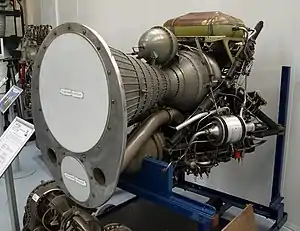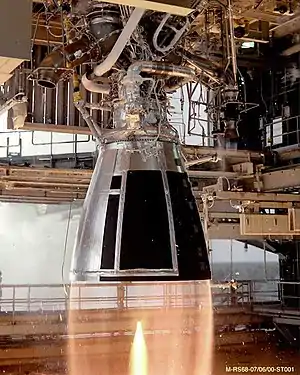| Stentor | |
|---|---|
 | |
| Stentor rocket engine showing the large main nozzle (top) and the smaller cruise nozzle (bottom) | |
| Type | Rocket engine |
| National origin | United Kingdom |
| Manufacturer | Armstrong Siddeley |
| First run | c.1960 |
| Major applications | Blue Steel missile |
The Armstrong Siddeley Stentor, latterly Bristol Siddeley BSSt.1 Stentor, was a two-chamber HTP rocket engine used to power the Blue Steel stand-off missile carried by Britain's V bomber force.[1][2] The high thrust chamber was used for the first 29 seconds, after which it was shut down and a smaller cruise chamber was used for the rest of the powered flight.[3][4][5]
Design and development
It was fuelled by hydrogen peroxide with kerosene.[1]
The engine incorporated an integral tubular mounting frame which was attached by six lugs to the rear bulkhead of the missile airframe, the complete engine being enclosed in a tube-shaped fairing with the nozzles at the rear.
Applications
Engines on display
Preserved Stentor engines are on display at the following museums:
- Royal Air Force Museum Cosford
- Midland Air Museum
- The University of Liverpool, in the Department of Engineering foyer.
- South Yorkshire Aircraft Museum, Doncaster
- Newark Air Museum, Nottinghamshire
- Cambridge Science Centre, Cambridge
Specifications

Data from [6]
General characteristics
- Type: two chamber liquid-propellant rocket engine
- Length: 58 in (1,473 mm)
- Diameter: 38 in (965 mm) wide, 44.5 in (1,130 mm) high
- Dry weight: 747 lb (339 kg) including oil and nitrogen
- Fuel: kerosene
- Oxidiser: hydrogen peroxide
Components
- Pumps:
Performance
- Thrust: large boost chamber rated at 24,000 lbf (110 kN)
smaller cruise chamber rated at 6,000 lbf (27 kN) - Burn time:
- Thrust specific fuel consumption:
- Specific impulse: ~220 seconds (2.2 km/s)[7]
See also
Related development
Related lists
References
- 1 2 "Blue Steel and its Engine". Flight. Missiles and Spaceflight. 12 August 1960. pp. 214–215.
- ↑ Millard, Douglas (2001). The Black Arrow Rocket. Science Museum. p. 23-24. ISBN 1 900747 41 3.
In early 1956, the government contracted Armstrong Siddeley to develop a second HTP engine, this time for a quite different kind of vehicle called Blue Steel. [...] Blue Steel's engine was called Stentor
- ↑ "Stentor rocket motor". Skomer. Archived from the original on 20 April 2008.
- ↑ "Rocket Engines for Piloted Aircraft". Bristol Siddeley Magazine. 1960.
- ↑ "Blue Steel in Action". Flight: 329. 11 March 1960.
- ↑ S.D.4766B, Vol.1, Sect.4 - July 63
- ↑
Hill, C N (2001). A vertical empire. Imperial College Press. p. 64. ISBN 978 1 86094 267 9.
Burning HTP and kerosene, it produced a S.I. around 220.
